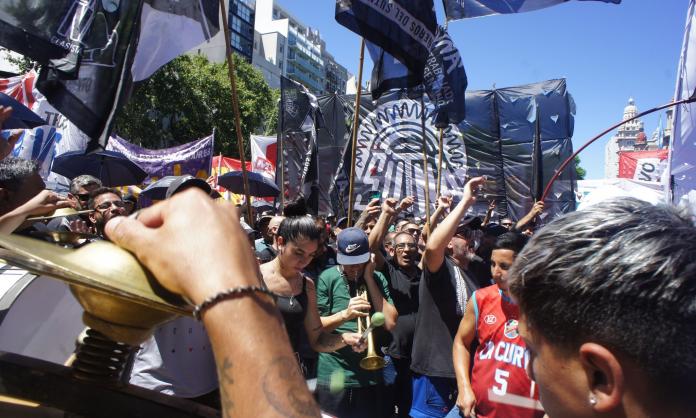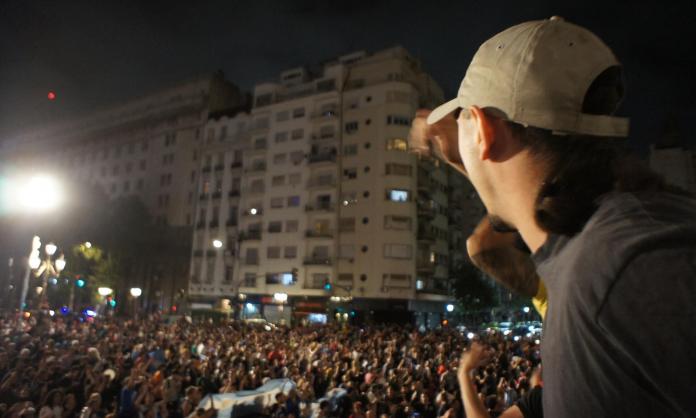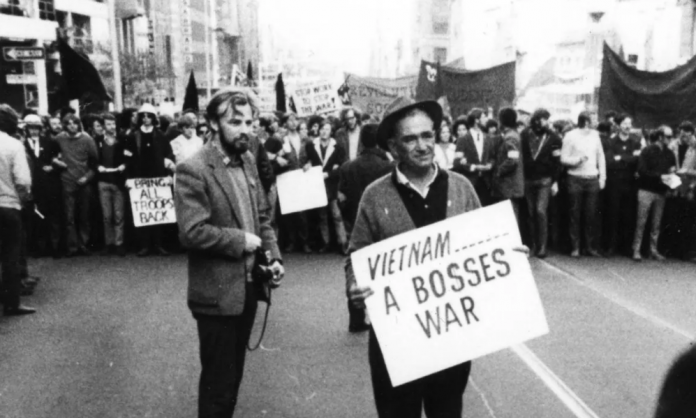The phrase “under workers’ control” is, unfortunately, not one we are accustomed to hearing. But twenty years ago, ceramics produced in the Zanon factory in Neuquén, Argentina, began to have these words proudly printed on them. The story of the workers behind the factory’s takeover is full of important lessons for revolutionaries.
Workers’ control of the Zanon factory was not spontaneous. It was the result of years of rank-and-file activism, partial victories, growing confidence and organisation among the workers, and a nearly revolutionary crisis—the Argentinazo (Argentina Uprising) of December 2001.
During the 1990s, discipline within the factory was so strict that any union organising outside of the official channels had to be done in secret. But in 1996, when a series of planned lay-offs coincided with union elections, a rank-and-file movement challenged the right-wing officials and launched a fightback against management. The lay-offs were defeated by a three-day strike that resulted in the factory manager being sacked instead.
The victory was the embryo of a new type of union movement, which led to a historic vote two years later, when the union’s activist wing—known as the Brown List, for the brown-coloured uniforms worn by the workers—won control of the union’s Internal Commission at Zanon.
“All we could say is that we wanted to change things”, one of the activists relates in the 2008 documentary Corazón de fábrica (Heart of the factory). “We always set our hopes on a leader, and he would sell us out, so that wasn’t going to happen. No member of the Brown List would negotiate. That went down well with the workers.”
From that day, the dynamics of the union and factory began to change. Internal democracy grew, and large assemblies were convened to debate and vote on policy. It was due to this newfound sense of confidence that, when a young worker died at the factory in 2000, the workers went on strike for eight days, and then voted to continue for an additional day even after the strike was ruled to be illegal. Raúl Godoy, a key leader at Zanon, notes in Zanon. Fábrica militante sin patrones—his book about the role of Trotskyists in the struggle—that when the vote was carried to extend the strike, a spontaneous chant broke out: “Unity of the workers, and those who don’t like it can get screwed!”
By extending the strike for just that one extra day, the Zanon workers won improved safety conditions, a permanent ambulance and doctor on site and protection from lay-offs and suspensions. And they were paid for all nine days on strike. Thus the first seeds of workers’ control were planted with the union winning control over factory safety.
Throughout 2001, as an already dire economic crisis worsened, several national general strikes were called by Argentina’s union confederations. In December, the government’s decision to limit bank withdrawals brought the middle classes into the streets with the working class, giving birth to what has become a rallying cry of all Latin American rebellions since, “Que se vayan todos!” (They all must go!)
Chris Harman, a Marxist who visited Argentina during the crisis, compared the situation to the revolutionary days of 1923 Germany, when workers came closer than ever to taking power in an advanced industrial country. “Two of the key elements in Lenin’s description of a revolutionary situation are present—the mass of people are not prepared to continue in the old way, and the ruling class itself cannot do so either”, he wrote in the British magazine Socialist Review.
As the Argentinazo erupted, the Zanon workers were already locked in a fierce battle against the bosses and state government. In October, management had initiated a lockout. The workers responded by occupying the premises. Within days, they had formed a workers’ guard to defend the factory and a women’s commission, which played a key role in coordinating different elements of the struggle. Students and workers from other factories also visited to express their solidarity and learn from the Zanon workers.
“Just like that, workers who only yesterday were rank-and-file comrades, quickly became activists and leaders in a phenomenon that radically changed them”, Godoy writes. The occupation enjoyed broad popular support in the state of Neuquén. At a local university where students were raising a strike fund, Godoy notes that a popular slogan was heard: “One student, one peso. We are thousands. Thousands of pesos for the triumph of the Zanon strike!”
Throughout the months of the occupation, debates occurred inside the factory about tactics and what victory would look like. Initially, there was no consensus on maintaining the occupation. Indeed, the harsh repression suffered at the hands of state authorities was discouraging for many. But in those difficult times, a strong core of principled leaders, in the democratic assembly system set up years before, won the argument to continue the struggle and convinced the wavering workers not to give up.
Inside the factory, the debates were strongly influenced by the broader movement in Argentina. A crucial moment came when the Argentinazo experienced its most violent two days in Buenos Aires on 19 and 20 December 2001, when at least 36 people were killed by the state. In the wake of the killings, the Zanon workers began to realise that victory meant continuing the struggle and going even further. This was the moment when the question of restarting production under workers’ control was seriously raised for the first time.
At one point during the occupation, a local judge came to the factory to explain to the workers that their occupation was illegal. Alberto Barrera, an oven sector worker at Zanon, recounts in Heart of the factory what he told the judge:
“Look, madame, I don’t know what position you hold, but I’ll tell you, with all the years I’ve spent here in Zanon burning myself, making sacrifices, never missing a day, you might get me out—but it’ll be feet first ... If you want a massacre on your hands, no problem. We’re determined to face that. We have our hands, our slingshots and more.”
By March 2002, the decision was made to restart production. Initially, the workers faced great difficulties in doing so. First and foremost was simply acquiring the necessary raw materials—former suppliers were refusing to provide them. But by turning to the wider community, the workers found solutions. Previously, the indigenous Mapuche people of Neuquén had refused to provide clay, a crucial ceramics input, to the factory. But when the workers took over, the Mapuche people stepped in to provide it from their territory, helping the factory to start again.
“The relationship we had [before the occupation] with Zanon was one of conflict, but there was a radical change in that relationship when the Zanon workers took control of the factory”, one Mapuche activist relates in the documentary Zanon, the red thread. “From there began a new relationship of dialogue, respect and our needs, which strengthened our own fight.”
Another problem that arose was acquiring boxes. “No one wanted to sell us boxes”, Rulo, a member of the purchasing committee, said in an interview with academics from La Plata National University. “We put an ad in the Neuquén newspaper and a man that made pizza boxes came to us. He started making boxes with a machine from the year 1900—today he is our main provider.”
When production restarted under their own control, workers did not return to the days of strict obedience under the threat of sacking. Instead, the factory relationships were revolutionised. Every aspect of production—planning, materials, safety, wages, hiring, output, distribution—was now geared to the needs of the workers themselves and the wider community in which they lived.
Each section of the factory elected a coordinator, who continued working but with extra responsibility for organisational issues. All the workers also elected a general coordinator of the factory. And everyone received the same salary.
It is a lesson in how society could be vastly different if workers controlled the means of production. Instead of aimlessly producing what the bosses ordered, the workers decided what to produce. For example, to show their solidarity and gratitude to the Mapuche people, the Zanon workers made a series of products with Mapuche art designs on them. They also contributed to community projects like hospitals and schools, as well as training and education for the unemployed.
Over the next decade, the workers faced several eviction attempts by local police. Ironically, the pressure from authorities forced them to stay highly organised. A member of the factory’s workers’ guard interviewed in Heart of the factory recounts preparations to defend against an eviction attempt in 2003:
“We discussed it so frankly that we said, ‘Compañeros, we are ready to do anything. Let’s discuss whether we use guns or not, and how far we’re willing to go’. And that night, several comrades said, ‘I’m staying, count on me to do whatever’.”
The following day, thousands of people surrounded the factory and helped to defeat the eviction. After years of fighting, in 2012 the Zanon workers received official legal recognition of their control of the factory, which was renamed FaSinPat, a shortening of fábrica sin patrones, which means “factory without bosses” in Spanish.
Technically, it remains under workers’ control. But the harsh reality of isolation has forced it to incorporate capitalist elements of production. The dynamics of the capitalist economy that force firms to compete make it impossible for even a worker-run enterprise to escape the pressures of the market.
Yet the heroic struggle of the workers is full of lessons for socialists. It shows how workers’ consciousness can be transformed through struggle and how opportunities arise for them to exercise their power as part of their class instead of as isolated individuals. It shows the importance of building a workers’ movement that is independent of the union leaders, and that prioritises collective, rank-and-file decision-making. And it shows that workers don’t need the bosses to run production for themselves.
Ultimately, the legacy of Zanon is perhaps best summed up by Godoy:
“Sometimes instead of reading my daughter stories, I’d read her stories of the Russian revolution or the (Communist) Manifesto, and she’d say, ‘That sounds nice, but it will never happen’. When she turned 15, she gave me a photo of a march she was in, because she’s an activist, and she said, ‘When you told me those things, I’d think how good my old man’s intentions were, but they’re things that will never come true. Now, after seeing what you did in Zanon, I’ve started believing it’s all possible’.”










